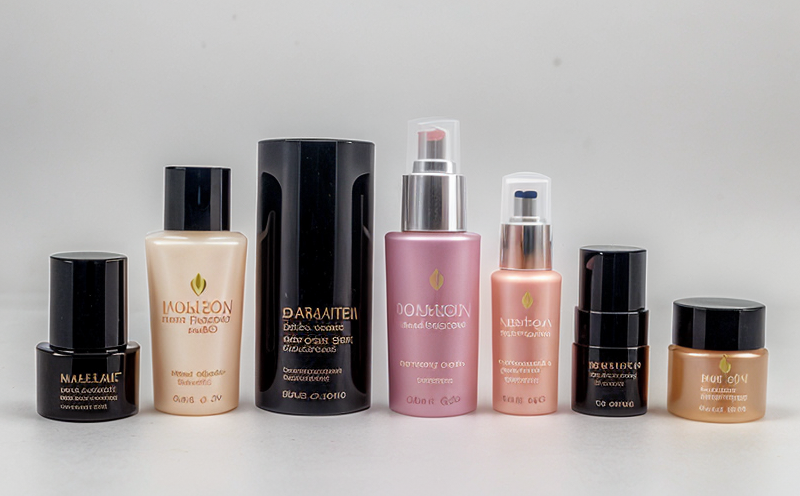Temperature Cycling Impact Testing on Packaging
The importance of packaging interaction testing in cosmetics cannot be overstated. The cosmetic industry is increasingly focused on ensuring that packaging does not compromise the integrity or safety of its products, especially as regulations around allergens and contaminants become more stringent.
Temperature cycling impact testing specifically examines how packaging behaves under fluctuating temperature conditions. This type of testing helps to identify potential weaknesses in design or manufacturing processes that could lead to migration issues when the product is exposed to real-world environmental conditions. Migratory substances from packaging can include metals like tin, chromium, and iron, as well as other compounds such as benzophenone-3 (BP-3), which may leach into the cosmetic formulation.
Testing is conducted using standard procedures that simulate the temperature variations a product might encounter during distribution and storage. This includes extreme hot and cold cycles, which are designed to mimic real-world conditions like shipping in summer heat or refrigeration in winter months. The objective of these tests is to determine whether there will be any adverse effects on the cosmetic product due to interactions between its packaging material and the formulation.
The results from temperature cycling impact testing play a critical role in ensuring compliance with international standards such as ISO 13960, which provides guidelines for the design of packaging systems that minimize migration risks. Additionally, these tests are crucial for maintaining brand reputation by preventing recalls due to safety concerns or regulatory non-compliance.
For effective testing, it's essential to prepare specimens correctly before placing them into the temperature cycling chamber. This involves carefully selecting representative samples from different batches or production runs to ensure they accurately reflect the variability within a batch or across multiple batches if applicable. Proper preparation also includes ensuring that all labels and identification marks are preserved so that results can be traced back directly to specific products.
The equipment used for this testing typically consists of temperature cycling chambers capable of precisely controlling both heating and cooling rates while maintaining accurate temperatures throughout the entire range needed for effective simulation. These chambers often come equipped with data logging capabilities allowing continuous monitoring during each cycle run. Reporting follows strict protocols outlined by relevant industry bodies, providing detailed information about observed changes in packaging integrity as well as any potential impacts on product quality.
- Data collected includes measurements of thickness change, color shift, and appearance modifications to assess whether the packaging has undergone significant deterioration over repeated cycles.
- Leachable analysis is performed following completion of the test sequence to quantify any contaminants that may have migrated into the cosmetic product during testing.
Why It Matters
The significance of temperature cycling impact testing on packaging extends beyond mere compliance with regulations; it also serves as a vital tool for enhancing brand reputation and consumer trust. By demonstrating commitment to quality assurance through rigorous testing protocols, companies can build stronger relationships with their customers while reducing the risk of adverse reactions or health hazards associated with compromised product integrity.
Moreover, successful implementation of such tests allows manufacturers to optimize their packaging designs more effectively by identifying areas where improvements are needed. This not only enhances overall performance but also contributes positively towards sustainability goals by promoting longer-lasting products that require less frequent replacement cycles.
In summary, temperature cycling impact testing on packaging is an indispensable practice for any company involved in the development and production of cosmetics or similar consumer goods. It ensures safety standards are met while fostering innovation through continuous improvement processes aimed at reducing waste and enhancing environmental responsibility across supply chains.
Scope and Methodology
The scope of temperature cycling impact testing on packaging encompasses a wide range of factors that could affect the interaction between cosmetics and their containers. This includes evaluating how various materials might behave under different environmental conditions, assessing potential risks posed by contaminants migrating from packaging into the product, and determining appropriate measures to mitigate these risks.
The methodology employed involves subjecting specimens of representative packaging components to controlled temperature cycles that replicate expected real-world scenarios. During this process, detailed observations are made regarding any observable changes in physical properties or chemical composition. Leachable analysis is conducted post-testing to measure the amount and nature of any contaminants present within the cosmetic product after exposure.
Standardization plays a key role in ensuring consistent results across different laboratories conducting similar tests. International standards such as ISO 13960 provide guidance on proper procedures for designing packaging systems that minimize migration risks, which can then be followed during testing to ensure accuracy and reliability of findings.
Environmental and Sustainability Contributions
- By identifying early any potential issues with packaging design or manufacturing processes related to temperature cycling impacts, companies can take corrective actions that reduce waste generation throughout the product lifecycle. This contributes positively towards reducing landfill contributions.
- Optimized packaging designs resulting from successful testing lead to reduced material consumption and energy usage during production, supporting broader environmental goals.





